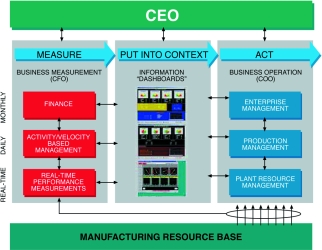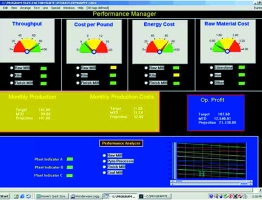
In Part 4 we saw the necessity for the efficient use of the MES communication ‘hub’. While a great deal of work is being done to simplify the exchange of information between ERP, MES and control systems using standards such as ISA-95, work is also being done on what information should be communicated and for what purpose. High on the agenda of CEOs worldwide, is performance management at all levels of their organisations that increase opportunities for improvement through the availability of right-time and relevant information.
Having structured the enterprise as an engine for realising the company's business objectives, it is now time to measure its performance against set criteria and to take remedial action where necessary. Generally speaking, performance measurement is currently only being applied to the business generation (sales) and wealth creation (manufacturing/production) aspects of the organisation. But performance management applies to each and every process and sub-process of the company - from accounting and logistics to human resources and information management, because they are all cogs in the objective-realisation machine.
It is normally at this point that people get mental pictures of a totalitarian regime where mindless, grey people go about doing the work of the élite. But nothing could be further from the truth. It is the machine that is subservient to its human operators. In 1999, Wonderware launched its vision for a plant-centric manufacturing approach, which showed that, as the people primarily responsible for creating the company's wealth, shopfloor operators needed to be the most informed. It is they who run the production machine and far from being mindless, they are the source of all valuable information about the company's production processes. And as for the élite, well the new scheme of things shows that they will get scrutinised with the same interest they now scrutinise others.
There is no doubt that the principles of process control work - otherwise, the world's largest and most successful corporations would not entrust their wealth-creating processes to them. Today, CEOs are showing a keen interest in extending the successes of their production facilities to other parts of their organisations - like accounting!

In 2003, Dr Peter G. Martin PhD, vice president at the performance measurement and management unit of Invensys Production Management, introduced the concept of Bottom Line Automation. A concept that extends business performance measurement beyond traditional accounting to the realities of realtime production. It was developed after more than 300 CEOs underlined the inability of their office systems to provide the information required to address problems in a timely manner. (Dr Martin has been hailed by Fortune Magazine as a 'Hero of US Manufacturing' and was selected by the ISA as one of the industry's '50 most influential innovators', ranking with Edison and the Wright Brothers.)
In 2005, Dr Martin once again addressed this subject and showed how companies worldwide are benefiting from the application of dynamic performance management (DPM). The same CEOs who were less than satisfied with their current approaches wanted to map this approach into their organisations. Most of them have the following in common:
* They no longer want to work with isolated solutions and want an holistic approach to their information needs.
* They need access to up-to-date financial and operational information all the time - not just after month-end.
* They need to monitor cause and effect scenarios at the operational level while measuring their effect at the financial level.
* They want to share their responsibilities with the rest of their staff who need right-time information to be effective at all levels.
It is important to note that implementing dynamic performance management need not entail purchasing more hardware or software. Many manufacturers already have the necessary infrastructure and the technology required is not at all new. We can measure and monitor anything we want. The important thing to realise is that we can measure and control business processes just like we can measure production processes.

Extending business performance measurement beyond finance into the realtime world of MES and production will mean that IT of the top floor and IT of the shopfloor will have to work in concert if they are to deliver the information goods at all levels of the organisation in time frames that will allow for corrective action to be taken. If this sounds complex, it is, in fact, less complex than what has to happen in the realtime environment of shop floors every day.
Dynamic performance management is not a package that one can simply install and run. It has to be crafted for each company depending on the systems they have, the information they need at all levels and, most importantly, the attitude of management and staff towards an environment where transparency and performance accountability are key. While the bottoms-up approach has driven manufacturing companies to new heights over the last few years, Dynamic performance management is a top-down approach that needs to be driven by CEOs, CFOs and COOs who realise the immense benefits to be had from measuring their business processes with the same efficacy as their production processes.
In the next and final part, we will look at some of the questions that this series of articles may have triggered in your mind.
For more information contact Justin Tweedie, Futuristix, 0861 WONDER (0861 966 337), [email protected] or [email protected]

© Technews Publishing (Pty) Ltd | All Rights Reserved